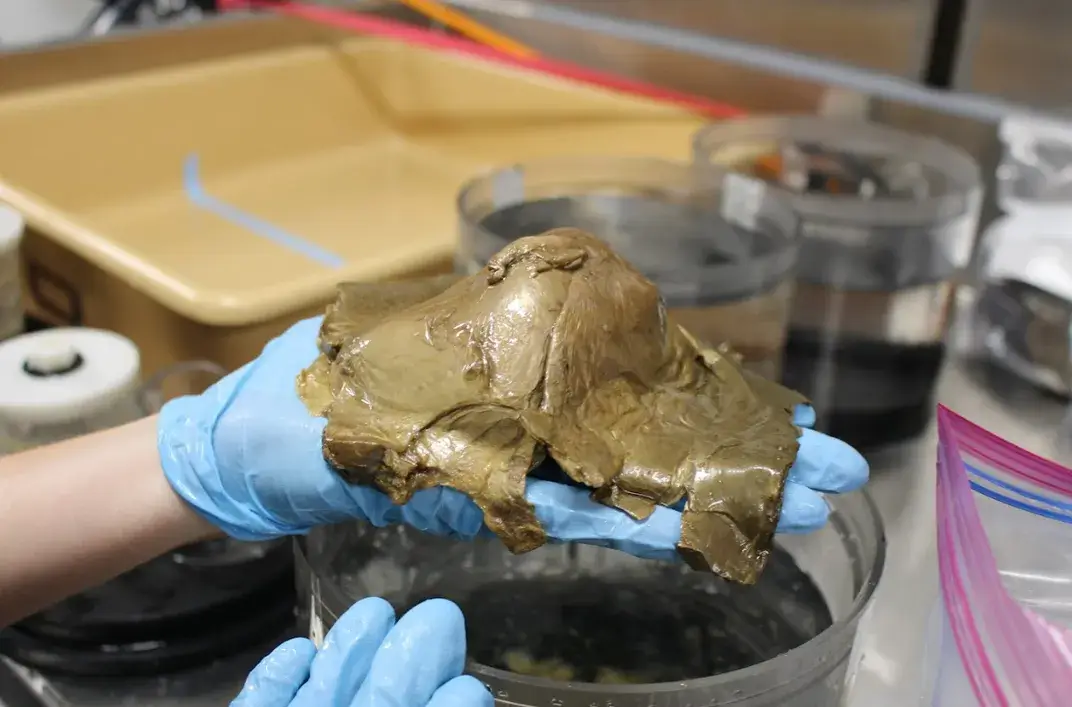
What Is This Mysterious Golden Orb Scientists Found On The Ocean Floor?
After bringing the four-inch-diameter blob to the surface, researchers still only know that it is “biological in origin”
By: Sarah Kuta | Smithsonian
Scientists are baffled by a mysterious blob they found on the ocean floor, deep underwater off the coast of Alaska.
The bizarre object—which is about four inches in diameter and has a tannish-gold color—“struck an imaginative chord” with researchers and casual onlookers alike, the National Oceanic and Atmospheric Administration (NOAA) posted on X, formerly known as Twitter.
Scientists stumbled upon the smooth, soft object stuck tightly to a rock about two miles below the surface of the Pacific Ocean on August 30. They had been using remotely operated vehicles (ROVs) to map deepwater habitats near Alaska as part of NOAA’s Seascape Alaska 5 expedition.
In a live-stream of the mission, researchers can be heard discussing the puzzling discovery, throwing around their theories—and even a few jokes—about what it could be. Their guesses ranged from egg casing to coral to an encrusting sponge. And one trait that really caught their attention was a small hole in the object, as if something had gone in or come out.
“It’s like the beginning of a horror movie,” one scientist said.
“Pretty sure this is how the first episode of the ‘X Files’ started,” said another.

Using a gentle suction attachment on the ROV, they carefully extracted the object from the seafloor and brought it to the surface for further study in the wet lab of their ship, the Okeanos Explorer.
Even upon closer examination, however, they still couldn’t identify it “beyond the fact that it is biological in origin,” says Sam Candio, the expedition’s coordinator, in a statement. Next, they hope to get it into an on-land lab with more sophisticated equipment.
Scientists often see new things on exploratory missions like this one, but usually, they’re able to broadly categorize them.
“What’s unusual about this thing is we’re not even sure what it is,” says Kerry Howell, a deep-sea ecologist at the University of Plymouth in England, to the Guardian’s Hannah Devlin. “Is it an egg, is it a sponge, what is it?”

The Seascape Alaska 5 expedition started August 23 in Kodiak, Alaska, and will end on September 16 in Seward, Alaska, according to NOAA. Scientists are investigating unexplored regions in the Gulf of Alaska using ROVs and multibeam sonar technologies at depths between 650 and 19,700 feet (200 and 6,000 meters). Overall, their goal is to “fill gaps in our understanding” of the region through studying “deep-sea coral and sponge habitats, fish habitats, chemosynthetic communities and the water column and to improve knowledge of past and potential geohazards,” per NOAA.
The golden orb illustrates the importance of the mission—and ocean exploration more broadly, says Candio in the statement. It could represent a previously undiscovered species, or it may be an existing species going through an unknown life stage.
Either way, finds like this one could prove useful, such as by revealing “new sources for medical therapies and vaccines, food, energy and other societal benefits and knowledge,” he adds.
“Isn’t the deep sea so delightfully strange?” he says in the statement.
At the very least, the golden dome is “certainly nothing that should worry us,” as Jon Copley, a marine biologist at the University of Southampton in England, tells the Washington Post’s Adela Suliman.
“We often find things in the deep ocean that we haven’t seen before or don’t immediately recognize, because the deep ocean is vast and we’ve only been exploring what lives there over the past couple of centuries, unlike life on land,” he tells the publication.
* * *
NEXT UP!
Proof of The Parallel Universe? Nazi Coin From 2039 In Mexico Sparks Bizarre Theories
For a long time, alternative universes have been used as a plot for a novel or simply a story for a movie. But there are many who wonder what their life would be like in a parallel universe, or if there is an alternative version of themselves in another dimension. For what scientists have also spent time investigating the potential of alternative realities for decades.
Over the years, scientists have exposed multiple theories, some of which have real evidence to back them up. So, if any of these theories is correct, there is a universe somewhere different from ours. One of the most popular theories of the alternative universe is string theory.
According to this theory, we live in a multiverse of nine dimensions, with only three dimensions visible to us.
* * *
READ MORE: Did NASA Accidentally Show The Harbinger of The Apocalypse Nibiru On Live Stream?
Trending: Submarine Almost Collides With Alien Spacecraft Underwater (Video)
Liked it? Take a second to support Collective Spark.
We’d love to hear from you! If you have a comment about this article or if you have a tip for a future Collective Spark Story please let us know below in the comment section.
